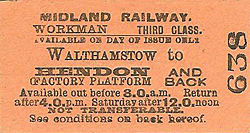Notes: The first airfield at Hendon was established in 1909 when a local company, Everett & Edgcombe, built an aeroplane. To accommodate it they built a shed in a field at the end of Colindale Avenue. By October 1910 a large area had been cleared and other organisations were using the airfield, including a school founded by Louis Bleriot, the first person to fly an aeroplane across the English Channel.
In 1911 Claude Grahame White bought the land and promoted the site as the London Aerodrome. On 12 May a military flying display was held and in September the first British airmail service was started. Air displays and races were held on most weekends, bringing the new technology to the attention of a wider public.
Although started as a civilian aerodrome with the outbreak of WW1 it soon took on a military role
when Claude Grahame White and other members of the Royal Naval Air Service (RNAS) mounted a night defence of London in 1915, constituting the very first aerial defence of London. In November 1916 the War Office commandeered the flying schools at Hendon, after which the aerodrome trained 490 pilots.
Production of aeroplanes was one of the features of the aerodrome's activities under Claude Grahame White. During the war production increased rapidly. To facilitate the transportation of the 3500 workers and materials, The Midland Railway built a spur from the embanked main line with a passenger platform for workers close to the main line and a loop line around the airfield to the plant.
 |
The branch diverged from the down side of the Midland main line at Hendon Factory Sidings signal box, a little south of Silkstream Junction and close to the ‘Hendon Crossing’ flyover. It followed the main line for a short distance and was at ground level when it reached Aerodrome Road. It passed over this on a single track level crossing then, after a short distance, reached a loop. The western-most track of this loop served Hendon Factory Platform, which was reached by means of a fenced footpath off the north side of Aerodrome Road and, apart from a couple of small huts at its southern end, was completely devoid of buildings and lighting. Beyond the station and its loop, the branch continued as a single line around the aerodrome to serve the factory and eventually terminate a little short of the Edgware Road.
The branch was built so that materials required for aircraft manufacture and repair could be brought into the works complex, and only the short section between the junction and the station was intended for passenger use. The proposal to build the line was approved on 18th April 1918 and construction started almost immediately and the line was quickly completed with the first workers service running on 19th May 1918 before the platform had been inspected and approved by the Board of Trade. The Midland railway only provided the service as far as the station, the remainder of branch being worked by a locomotives provided by the government which were housed in a single road shed near the end of the branch.
The platform was inspected and approved on 14th August 1918 but because there were no lights the inspector stipulated that the platform couldn't be used in hours of darkness.
Construction of the line came late in the war and by the time it was operational the end of the war was approaching so it was very short lived. There is no recorded date for closure to passengers although it is believed that the service ceased in 1919. Hendon Factory sidings signalbox closed on 28th January 1921 and the connection with the main line was removed four months later.
 |
The Air Ministry took over the whole site in 1922, which led to a protracted and ugly legal action lasting until 1925 with Claude Grahame White leaving the site. Aircraft manufacture went into decline between the wars. After WW2 After the war the airfield was increasingly unsuitable, particularly because the runways were too short, and the close proximity of |
suburban houses made matters worse. The RAF argued the military importance of the complex into the 1950s in case future developments in aviation technology might render the base suitable again, but eventually Hendon Borough Council and the London County Council were able to argue that houses were needed more than the aerodrome.
The last flying unit, the Metropolitan Communication Squadron, left Hendon in November 1957. Late in 1968 when two-thirds of the runways had been removed a Blackburn Beverley, flown in to be an exhibit at the new RAF Museum, was the last aircraft to land in Hendon. The museum opened in 1972 and the RAF base finally closed altogether in 1987. The RAF Museum is now situated on south east side of the site. Much of the aerodrome is now the site of the Grahame Park Housing Estate and Hendon Metropolitan Police college.
Today little evidence of the short lived branch survives, only the engine shed, which is now used as a store in one corner of the Montrose playing field and the bricked up arch that took the single track line under the Northern Line's Edgware branch (running along the north east side of Montrose playing field) which opened in 1924 after the factory branch closed are the only evidence that the branch ever existed. The site of the platform is now lost under the new Beaufort Park housing development.
Sources: RAF Museum web site, Wikipedia the free encyclopedia and London's Disused Stations Volume 7 The Midland Railway by J E Connor. Published 2009 by Connor & Butler. ISBN 978 0 947699 42 2
Ticket from Michael Stewart, route map drawn by Alan Young
For other Midland Railway London suburban stations click on the station name: Welsh Harp, Finchley Road, Haverstock Hill, Camden Road, Dudding Hill & Harlesden for West Willesden and Stonebridge Park |

platform_old2.jpg)
platform_old3.jpg)







 Home Page
Home Page